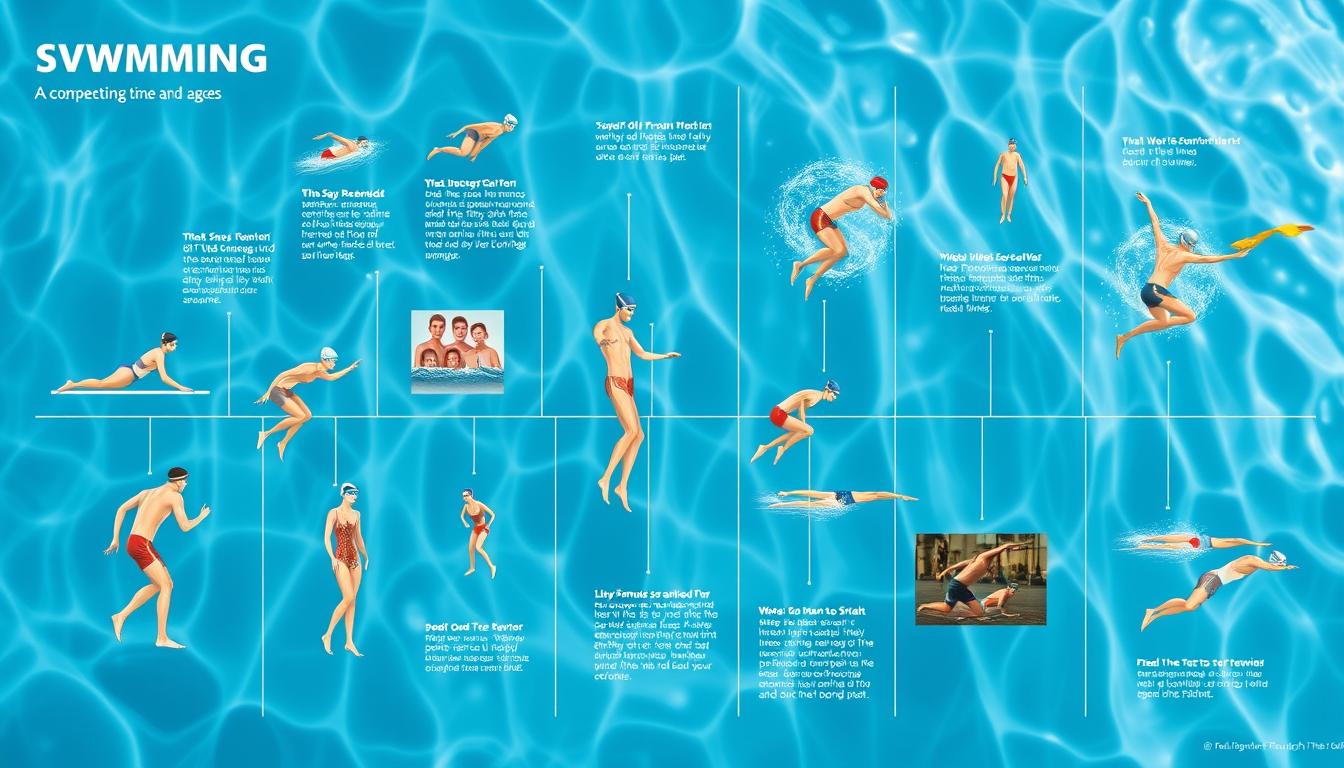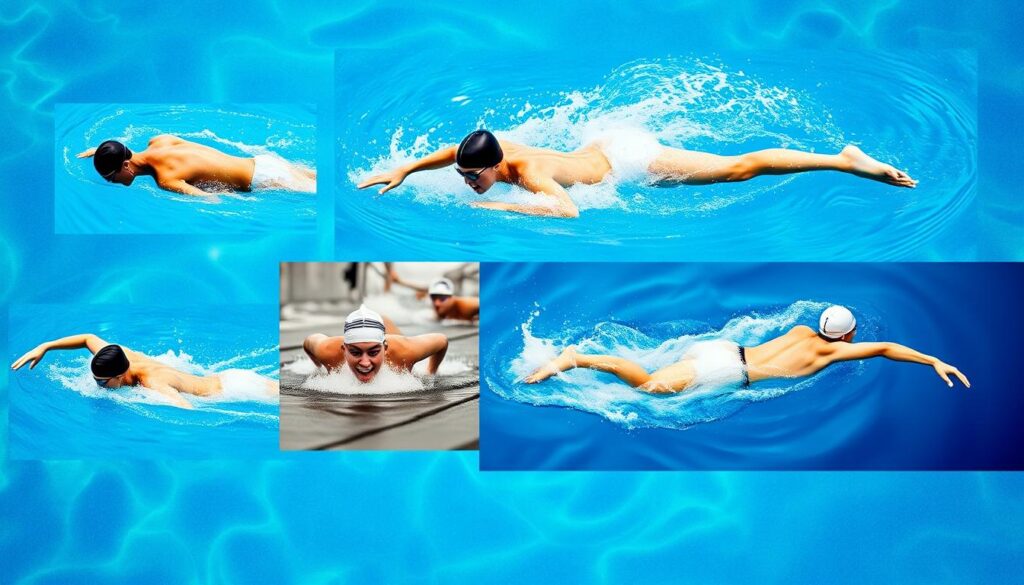The History of Competitive Swimming: A Timeline

Did you know the first swimming races were recorded in 36 BC in Japan? The history of competitive swimming is a long and exciting journey. It covers centuries, from ancient times to today’s Olympic events. This timeline shows how swimming evolved, with important milestones, pioneering swimmers, and new technologies.
Swimming has always been more than just a sport. It’s a vital skill, a fun activity, and a thrilling sport to watch. As we explore competitive swimming’s history, we’ll see how it grew into a global event. It has captivated people and inspired athletes worldwide.
Key Takeaways:
- Swimming races have been documented as far back as ancient Greece and the Roman Empire
- The modern era of competitive swimming began in the 19th century with the formation of swimming clubs
- Competitive swimming has evolved significantly over time, with new strokes, techniques, and technologies being developed
- Swimming has become a popular spectator sport, with extensive media coverage and the rise of swimming superstars
- Technological advancements in swimwear and timing systems have revolutionized the sport of competitive swimming
Early Beginnings of Competitive Swimming
Competitive swimming started in ancient times. Back then, swimming was a survival skill and a valued ability. People swam for fishing, bathing, and to escape danger. As civilizations grew, swimming became more competitive, especially in ancient Greece and Rome.
Ancient Greece and Roman Empire
In ancient Greece, swimming was part of military training and the Olympics since 1896 B.C. The Greeks saw swimming as a must-have skill for soldiers. It was also a favorite pastime for many.
Swimming in Greece was a test of strength and endurance. It happened in open waters like seas and rivers.
The Roman Empire also valued swimming skills. Roman soldiers had to know how to swim. The Romans built big public baths with pools for swimming.
These baths were for hygiene, relaxation, and swimming competitions. They were social hubs.
Swimming as a Survival Skill
Before competitions, swimming was mainly for survival. People swam for:
- Fishing and gathering food
- Bathing and personal hygiene
- Escaping danger, like floods or shipwrecks
- Crossing water for travel or exploration
As civilizations grew, swimming evolved. The ancient Greeks and Romans saw swimming’s potential as a sport. They set the stage for competitive swimming’s future.
“Swimming is a confounding sport, because sometimes you do it for fun, and other times you do it to not die. And when I’m swimming, sometimes I’m not sure which one it is.” – Demetri Martin
| Civilization | Swimming Purpose | Notable Facts |
|---|---|---|
| Ancient Greece | Military training, Olympic Games | Swimming included in Olympics as early as 1896 B.C. |
| Roman Empire | Military training, public baths | Roman legionaries required to be proficient swimmers |
| General Population | Survival skill (fishing, bathing, escaping danger) | Swimming was essential for practical purposes |
The Rise of Organized Swimming Competitions
Swimming became more popular as a sport and activity. This led to the need for organized races and rules. The early 19th century saw the start of swimming races and clubs, setting the stage for the sport’s growth.
First Recorded Swimming Races
Swimming races have been around for centuries. The first recorded races were in ancient Japan in 36 B.C. These races showed off swimmers’ skills and endurance, starting competitive swimming’s journey.
Swimming races spread to other parts of the world. In the early 19th century, they became popular in Europe, especially in England. The first race in England was in 1837, a big step for the sport.
Emergence of Swimming Clubs
As swimming races grew, so did the need for training and competitions. Swimming clubs were key in advancing the sport. The Maidstone Swimming Club, England’s first, was founded in 1844.
Clubs quickly grew in England and beyond. Clubs like the Arlington Swimming Club (1862) and the Brighton Swimming Club (1860) were established. They helped develop rules and regulations for the sport.
“The emergence of swimming clubs in the 19th century was a game-changer for competitive swimming. It provided a platform for swimmers to train, compete, and push the boundaries of what was possible in the water.” – Swimming Historian, Sarah Johnson
Swimming clubs were crucial for the sport’s growth. They helped make swimming more popular, attracting more people to watch and participate. As clubs grew, they paved the way for bigger competitions.
| Notable Early Swimming Clubs | Year Founded | Location |
|---|---|---|
| Maidstone Swimming Club | 1844 | England |
| Brighton Swimming Club | 1860 | England |
| Arlington Swimming Club | 1862 | England |
The rise of swimming competitions and clubs was a turning point. These developments helped the sport grow and evolve, leading to the competitive swimming we enjoy today.
Swimming in the Modern Olympic Games
The first modern Olympic Games were held in Athens, Greece, in 1896. Swimming was one of the original nine sports, with four events. These events were the 100m freestyle, 500m freestyle, 1200m freestyle, and 100m freestyle for sailors.
As the Games grew, so did swimming. New events were added, like breaststroke, backstroke, butterfly, and individual medley. This allowed swimmers to specialize and excel in their preferred strokes.
The Olympic Games are the top stage for swimmers. They get to show their skills, break records, and gain international fame. Their hard work and passion inspire athletes and grow swimming’s popularity worldwide.
“The Olympic Games have played a crucial role in the development and promotion of swimming as a sport. They have provided a platform for the world’s best swimmers to compete at the highest level, pushing the boundaries of human performance and inspiring future generations of athletes.”
Over the years, Olympic swimming has seen many unforgettable moments. Michael Phelps won eight gold medals in one Games, and Katie Ledecky dominated distance events. These achievements have set new standards in swimming.
| Olympic Games | Notable Swimming Achievements |
|---|---|
| 2008 Beijing | Michael Phelps wins 8 gold medals, breaking the record for most gold medals in a single Olympic Games |
| 2012 London | Missy Franklin wins 4 gold medals and 1 bronze at the age of 17 |
| 2016 Rio | Katie Ledecky wins 4 gold medals and 1 silver, setting world records in the 400m and 800m freestyle |
The Olympic swimming history is filled with triumphs, perseverance, and sportsmanship. The sport keeps evolving, with new champions and records. The Olympics remain the dream for swimmers worldwide. Swimming’s Olympic legacy shows the power of sport to unite people.
Evolution of Swimming Strokes and Techniques
Competitive swimming has seen many strokes and techniques evolve over time. From the ancient breaststroke to the modern butterfly, these changes have shaped the sport. Each stroke has its own story and development.

Breaststroke
The breaststroke is the oldest swimming stroke, dating back to the Stone Age. Swimmers and coaches have worked hard to improve its speed and efficiency. Today, it’s known for its arm and leg movements happening at the same time.
Freestyle
Freestyle, or front crawl, became popular in the early 20th century. It’s now the fastest stroke, thanks to innovations like the flutter kick and better arm movements. Athletes keep pushing the limits of speed and endurance in freestyle.
Backstroke
The backstroke started in the early days of competitive swimming. It was first used in the 1900 Olympic Games. Over time, the technique has improved, focusing on a streamlined body and strong movements.
Butterfly
The butterfly stroke came about in the 1930s as a faster version of the breaststroke. Sydney Cavill, an Australian swimmer, is credited with inventing it. It was officially recognized in 1952 and is now a challenging and impressive stroke.
| Stroke | Key Developments | Notable Pioneers |
|---|---|---|
| Breaststroke | Simultaneous arm and leg movements, streamlined technique | Frederick Holman, Kazuo Tomita |
| Freestyle | Flutter kick, refined arm movements | Johnny Weissmuller, Dawn Fraser |
| Backstroke | Streamlined body position, powerful arm and leg movements | Harry Hebner, Krisztina Egerszegi |
| Butterfly | Undulating body motion, simultaneous arm movements | Sydney Cavill, Mary T. Meagher |
The evolution of swimming strokes and techniques is ongoing. Swimmers, coaches, and researchers worldwide drive this progress. As the sport grows, we’ll see more innovations and refinements, pushing the limits in the pool.
Pioneering Swimmers and Their Achievements
Many swimmers have changed competitive swimming over the years. They’ve set records and inspired others. These pioneers have made swimming more popular and exciting.
Duke Kahanamoku, from Hawaii, won three gold medals at the Olympics. He also helped start surfing. Johnny Weissmuller, from the early 1900s, won five gold medals and became Tarzan in movies.
Today, swimmers like Mark Spitz, Michael Phelps, and Katie Ledecky are breaking records. Spitz won seven gold medals in 1972. Phelps has 28 Olympic medals, including 23 golds. Ledecky has set many world records in freestyle events.
“Swimming is normal for me. I’m relaxed. I’m comfortable, and I know my surroundings. It’s my home.” – Michael Phelps
Other notable achievements include:
- Gertrude Ederle was the first woman to swim the English Channel in 1926.
- Ian Thorpe won five Olympic gold medals and set 13 world records.
- Debbie Meyer was the first to win gold in all three distance freestyle events at one Olympics in 1968.
These swimmers have made swimming what it is today. Their achievements inspire new swimmers to reach for greatness.
The History of Competitive Swimming
As competitive swimming grew, the need for rules and organizations became clear. These groups shaped the sport and ensured fair play globally.
Formation of International Swimming Organizations
The Fédération Internationale de Natation (FINA) was formed in 1908. It became the global leader for swimming, diving, and more. FINA’s start was a big step for swimming, bringing a unified set of rules and oversight.

FINA has promoted swimming worldwide, hosting big events like the World Championships. It also supports swimming in developing countries, helping to grow the sport.
Standardization of Rules and Regulations
FINA’s creation led to standardized rules in swimming. This ensured fair play and the sport’s integrity. FINA set standards for pool sizes, water temperature, and equipment.
FINA also manages swimming world records. It sets clear rules for record recognition and fights doping. This keeps swimming fair and clean.
“FINA’s role in the development of swimming cannot be overstated. The organization has been a driving force behind the sport’s growth and has helped to create a framework that allows swimmers from all corners of the world to compete on an equal footing.” – Mark Spitz, nine-time Olympic gold medalist
Standardized rules have helped both elite and grassroots swimmers. They’ve made it easier for local clubs and schools to offer training and competitions. This has encouraged more people to swim and love the sport worldwide.
Technological Advancements in Swimming
The world of competitive swimming has seen big changes thanks to new technology. Swimwear, timing, and scoring systems have all improved a lot. These changes help swimmers train better, compete more effectively, and set new records.
Swimwear Innovations
Swimwear has changed a lot over the years. Early swimmers wore simple cotton or wool suits. But, the 1950s brought synthetic materials like nylon and lycra, changing the game.
In the early 2000s, swimsuits made of polyurethane became popular. They cut down on drag and made swimmers more buoyant. This led to many world records being broken. FINA then stepped in to regulate these suits to keep things fair.
“The introduction of new swimwear technology has been a game-changer in competitive swimming. It’s incredible to see how far we’ve come from the early days of cotton suits to the sleek, high-performance designs we have today.” – Michael Phelps, Olympic swimmer
Timing Systems and Scoring
New timing and scoring systems have also changed swimming. No more manual stopwatches or hand-written results. Today, electronic systems ensure everything is accurate and fair.
Electronic touchpads at the end of each lane record finish times with great precision. These touchpads connect to systems that show results on scoreboards and computers instantly.
| Timing System | Accuracy | Features |
|---|---|---|
| Omega Quantum Aquatics | 1/1000th of a second | Touchpads, starting blocks with sensors, underwater cameras |
| Colorado Time Systems | 1/100th of a second | Touchpads, wireless timing, live web results |
| Daktronics Swimming | 1/100th of a second | Touchpads, LED scoreboards, meet management software |
Computerized scoring systems have also made things easier. They help spectators follow the action and coaches analyze their swimmers’ performances. These advancements have made swim meets more accurate, efficient, and enjoyable for everyone involved.
Swimming as a Spectator Sport
Competitive swimming has become a thrilling spectator sport, drawing fans worldwide. As swimming events grew, media coverage and popularity skyrocketed. This turned the sport into a global sensation.
Big events like the Olympic Games and World Championships are huge TV hits. Millions watch as swimming is showcased on TV and online. This lets fans see elite swimmers’ amazing performances live.
Rise of Swimming Superstars
Swimming superstars have made the sport more popular. Names like Michael Phelps, Katie Ledecky, and Caeleb Dressel are well-known. Their achievements and charm have attracted many fans and inspired new swimmers.
These icons have brought more media and spectators to live events. Fans go to aquatic centers to see their favorite swimmers. The athletes’ passion and dedication have made swimming a favorite sport.
FAQ
What is the origin of competitive swimming?
Competitive swimming started in ancient times. It was part of military training in ancient Greece and Rome. Swimming races were also featured in the ancient Olympic Games.
When did the modern era of competitive swimming begin?
The modern era started in the 19th century. Swimming clubs and competitions began to form. The first swimming club, Maidstone Swimming Club, was founded in England in 1844.
How have swimming strokes evolved over time?
The breaststroke is the oldest stroke, dating back to the Stone Age. Freestyle, or front crawl, became popular in the early 20th century. It’s now the fastest stroke.
Backstroke was introduced in the 1900 Olympic Games. Butterfly emerged in the 1930s as a breaststroke variant. It was officially recognized as a separate stroke in 1952.
Who are some of the most famous swimmers in history?
Many swimmers have made a big impact on the sport. Duke Kahanamoku won three gold medals at the Olympics. Johnny Weissmuller won five gold medals.
Mark Spitz won seven gold medals at the 1972 Olympics. Michael Phelps holds the record with 28 medals. Katie Ledecky has broken many world records in freestyle events.
What role have international swimming organizations played in the development of the sport?
International organizations like FINA have been key. FINA was founded in 1908. It governs swimming, diving, and other aquatic sports worldwide.
FINA sets rules for competitions and keeps track of world records. Its work has helped standardize competitive swimming.
How have technological advancements impacted competitive swimming?
Tech has changed swimming a lot. Better pools and swimwear have helped athletes. The 2000s saw a big jump in records with new swimsuits.
Electronic timing and touchpads have made results more accurate. Computer systems have made scoring easier and faster.
How has competitive swimming grown as a spectator sport?
Swimming has become a big spectator sport. The Olympics and World Championships draw huge crowds. TV and online coverage reach fans worldwide.
Swimming stars have made the sport even more popular. They inspire new swimmers and fans.
